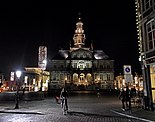Our website is made possible by displaying online advertisements to our visitors.
Please consider supporting us by disabling your ad blocker.
Maastricht
Maastricht
Mestreech (Limburgish) | |
|---|---|
City and municipality | |
River Meuse in winter Maastricht City Hall at night Sidewalk cafés at Onze Lieve Vrouweplein Our Lady, Star of the Sea chapel St. John's and St. Servatius' churches at Vrijthof square View from Mount Saint Peter | |
| Anthem: Mestreechs Volksleed | |
 Location in Limburg | |
| Coordinates: 50°51′N 5°41′E / 50.850°N 5.683°E | |
| Country | |
| Province | Limburg |
| Settled | ≈ circa 50 AD |
| City rights | gradually acquired |
| City Hall | Maastricht City Hall |
| Boroughs | 7 districts
|
| Government | |
| • Body | Municipal council |
| • Mayor | Wim Hillenaar (CDA) |
| Area | |
• Municipality | 60.12 km2 (23.21 sq mi) |
| • Land | 55.99 km2 (21.62 sq mi) |
| • Water | 4.13 km2 (1.59 sq mi) |
| Elevation | 49 m (161 ft) |
| Population | |
• Municipality | 120,227 |
| • Density | 2,147/km2 (5,560/sq mi) |
| • Urban | 277,721 |
| • Metro | ≈ 3,500,000 |
| Urban population for Dutch-Belgian region;[6] metropolitan population for Dutch-Belgian-German region.[7] | |
| Demonyms | (Dutch) Maastrichtenaar; (Limb.) Mestreechteneer or "Sjeng" (nickname) |
| Time zone | UTC+1 (CET) |
| • Summer (DST) | UTC+2 (CEST) |
| Postcode | 6200–6229 |
| Area code | 043 |
| Website | www |
Maastricht (/ˈmɑːstrɪxt/ MAH-strikht, US also /mɑːˈstrɪxt/ mah-STRIKHT,[8][9][10] Dutch: [maːˈstrɪxt] ; Limburgish: Mestreech [məˈstʀeːx]; French: Maestricht (archaic); Spanish: Mastrique (archaic)) is a city and a municipality in the southeastern Netherlands. It is the capital and largest city of the province of Limburg. Maastricht is located on both sides of the Meuse (Dutch: Maas), at the point where the river is joined by the Jeker. Mount Saint Peter (Sint-Pietersberg) is largely situated within the city's municipal borders. Maastricht is adjacent to the border with Belgium and is part of the Meuse-Rhine Euroregion, an international metropolis with a population of about 3.9 million, which includes the nearby German and Belgian cities of Aachen, Liège, and Hasselt.
Maastricht developed from a Roman settlement (Trajectum ad Mosam) to a medieval river trade and religious centre. In the 16th century it became a garrison town and in the 19th century an early industrial centre.[11] Today, the city is a thriving cultural[citation needed] and regional hub. It became well known through the Maastricht Treaty and as the birthplace of the euro.[12] Maastricht has 1,677 national heritage buildings (rijksmonumenten), the second highest number in the Netherlands, after Amsterdam. The city is visited by tourists for shopping and recreation, and has a large international student population. The last stage of the Cretaceous period and the Mesozoic era, the Maastrichtian, is named after this city, at the end of which was the Cretaceous–Paleogene extinction event, which resulted in the extinction of the non-avian dinosaurs.
- ^ "Mrs. Annemarie Penn-te Strake" [Mr. Annemarie Penn-te Strake] (in Dutch). Gemeente Maastricht. Archived from the original on 3 July 2015. Retrieved 12 October 2013.
- ^ "Kerncijfers wijken en buurten 2020" [Key figures for neighbourhoods 2020]. StatLine (in Dutch). CBS. 24 July 2020. Retrieved 19 September 2020.
- ^ "Postcodetool for 6211DW". Actueel Hoogtebestand Nederland (in Dutch). Het Waterschapshuis. Archived from the original on 21 September 2013. Retrieved 12 October 2013.
- ^ "Bevolkingsontwikkeling; regio per maand" [Population growth; regions per month]. CBS Statline (in Dutch). CBS. 1 January 2021. Retrieved 2 January 2022.
- ^ "Bevolkingsontwikkeling; Regionale kerncijfers Nederland" [Regional core figures Netherlands]. CBS Statline (in Dutch). CBS. 1 January 2020. Retrieved 8 March 2021.
- ^ Including the Belgian municipalities of Lanaken, Riemst and Maasmechelen to the west and Visé to the south.
- ^ Basically, the metropolitan areas of Maastricht, Liège, Hasselt-Genk, Sittard-Geleen, Heerlen-Kerkrade and Aachen-Düren constitute the densely populated urban core of the Meuse–Rhine Euroregion.
- ^ "Maastricht". The American Heritage Dictionary of the English Language (5th ed.). HarperCollins. Retrieved 4 April 2019.
- ^ "Maastricht" (US) and "Maastricht". Lexico UK English Dictionary. Oxford University Press. Archived from the original on 22 March 2020.
- ^ "Maastricht". Merriam-Webster.com Dictionary. Merriam-Webster. Retrieved 4 April 2019.
- ^ "Zicht op Maastricht". zichtopmaastricht.nl. Retrieved 19 August 2012.
- ^ "The Economist Charlemagne: Return to Maastricht Oct 8th 2011". Economist.com. 8 October 2011. Retrieved 23 May 2012.
Previous Page Next Page













